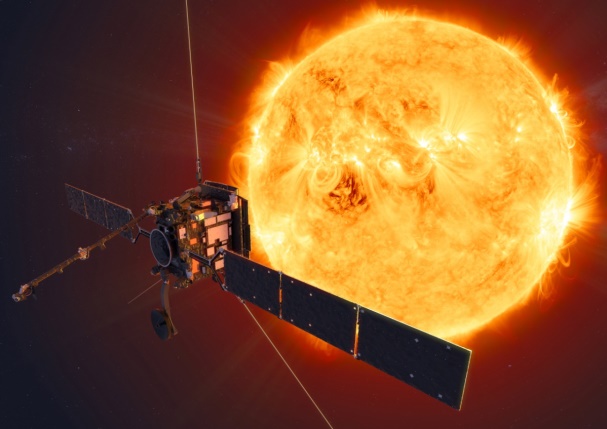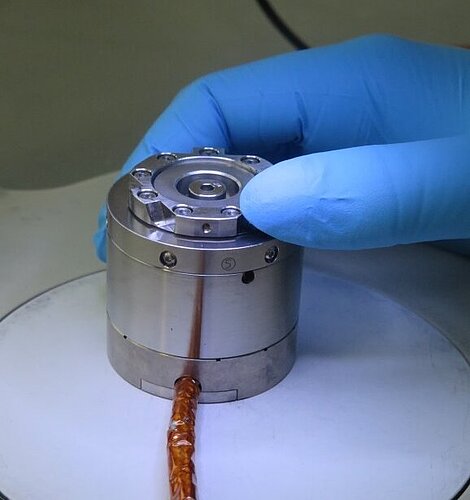
"Fusion reactor" | "godly star" | "jewel of creation" – Researchers, poets, and mystics have given our daytime star numerous names. Beside the highest regard for the Sun, the many still unresolved questions regarding the Sun's nature are also summed up in all these names. The >> Solar Orbiter space probe begun its journey in February 2020 in order to solve at least some of these secrets. Also on board: A tip/tilt unit from PI for the secondary mirror of one of the central experiments, the Polarimetric and Helioseismic Imager (PHI).
The Solar Orbiter received its "ready-for-take-off" call at 5:03 am on February 10, 2020, in Cape Canaveral AFS Launch Complex 41. The main objective of this joint project between the European Space Agency (ESA) and NASA is to study the formation of the solar wind and the underlying dynamic processes on the sun. A few days ago, ESA published some first images, which have attracted worldwide attention and even first >> TV broadcasts testify to the great interest.
Of particular importance under the ten different instruments on board of the orbiter is the Polarimetric and Helioseismic Imager (short: PHI) developed by the Max Planck Institute for Solar System Research in cooperation with the Leibniz Institute for Solar Physics. >> PHI will provide images of the solar surface (photosphere) in the visible light spectrum. In addition, the instrument will determine the strength and direction of the magnetic fields as well as the flow velocity of the plasma at the solar surface. Among others, conclusions on the plasma movement inside the Sun are expected from this information. In order to balance microvibrations of the satellite, a sophisticated image stabilization system is required. The solution, which was decided upon by researchers of the Leibniz Institute, is based on a tip/tilt unit from PI that moves the secondary mirror of the telescope; it weighs 71 grams and is made of Zerodur.
Arne Bramigk, the main developer of the tip/tilt unit, today looks back on 10 years of successful development work, "the tip/tilt unit is in many ways of great importance for us. Today, we can so justifiably claim that our system is suitable for space. Who else can say that? This means both, ensuring its functioning at extremely high temperatures and in high vacuum. Even, for example, massive loads due to high accelerations during the start of the satellite must be coped with." But the basic requirement for the tip/tilt unit alone presented Bramigk and the team with great challenges: A displacement of ± 295 µrad, bandwidth of 300 Hz, and a resonant frequency (with load) of 1.3 kHz. "This could only be achieved by employing directly driven piezo tip/tilt mirrors; the mechanics is made of a special titanium alloy. In this project, we learned a lot about surface treatments and about FEM model calculations," Bramigk tells the inside story.
Dr. Joachim Woch, PHI project manager at the Max Planck Institute for Solar System Research, is pleased about the successful start of the mission: "The commissioning of PHI in space has been successfully completed. The first photos taken by PHI of the photosphere of the sun are of excellent quality. All technical subsystems, including the PI tip / tilt unit, work without any problems."
Thanks to this successful implementation and beyond the immediate benefits, Bramigk sees a future potential in other missions for PI, where larger numbers could also be required. For example, for the optical communication from satellite to satellite or from satellite to Earth.
Currently, we can look forward to more spectacular images of our star – and to numerous scientific findings that researchers can draw from them.
PHI is made of two telescopes. The so called Full Disk Telescope (FDT) observes the entire sun disk at low angular resolution, while the High Resolution Telescope (HRT) observes a section of the solar surface of 1000 x 1000 arc seconds with its aperture of 14 cm.
This is where the image stabilization unit comes into play in order to achieve the angular resolution of one arc second specified in the scientific requirements and the required polarimetric accuracy. Under normal conditions, the remaining image movement between the shots must be less than 1/40 arc second (1/20 of a pixel of the scan detector).


